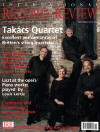Texte paru dans: / Appeared in:
*

International Record Review - (11//2013)
Pour
s'abonner / Subscription information
Naïve
V5333

0822186053331 (ID340)
Consultez toutes les évaluations recensées pour ce cd
~~~~ Reach all the evaluations located for this CD
This disc pays thrilling homage to one of the greatest castrati, Gaetano Majorano (1710-83), a.k.a. Caffarelli. He and his rival, Farinelli, both studied in Naples under the famously exacting Nicola Porpora. At just 16 Caffarelli debuted onstage in Rome playing a female role, Alvida in Domenico Sarro’s Valdemaro. Despite his prickly, sensitive, extravagantly self-regarding personality, he became the idol of Italian audiences during the next decade, prior to a single season in London (1737-38), where his singing of several Handel operas vas unsuccessful. He was best loved in Naples, .where he reigned for manv years as longtime leading singer of the chapel royal.
Caffarelli was a mezzo-soprano, and in todav’s (thankfully) castrato -less musical world, his repertoire lies too high for the vast majority of countertenors. Naïve’s disc identifies the Argentine singer Franco Fagioli as a countertenor, but on this evidence, his instrument while boasting easy access to nearly three octaves — belongs in mezzo- soprano tessitura. He’s probably better equipped to take on high-lying music written for castrati than any other male singer on disc. By comparison, male soprano Aris Christofellis some years ago was juvenile in timbre and interpretatively dull, while today’s French star countertenor, the technically brilliant Philippe Jarousskv, lacks sufficient tonal depth and variety of colour. Former male soprano Max-Emanuel Cencic with much warmer sound than those two — is, like Jaroussky, a fabulously accomplished artist, but he’s now really an alto, lacking the staggeringly full-throated upper extension that Fagioli brings to his Caffarelli programme.
In timbre, technique and style, Fagioli frequently bears a startling resemblance to Cecilia Bartoli. Stylistically they share a remarkable astuteness in matters of style, and vocally they’re each utterly fearless. Fagioli possesses complete control throughout his voice’s vast range (some low’ notes are admittedly a little odd - certainly not ‘raw’ chest tone, but nonetheless rather baritonal, sounding unbalanced with the rest of the voice). Occasionally Fagioli is below pitch above the stave, but never distressingly so. In negotiating superhumanly difficult coloratura, he’s definitely comparable to anyone singing pre-1800 repertoire today. He fields a reliable trill and his marksmanship in staccatos is astounding. In the more emotional and aggressive sections of these arias, his singing as with Barto1i can seem excessively supercharged. He’s most impressive in his long-breathed legato, his security in soft, unprepared high attacks and his command of messa di voce.
The arias cover two generations of composers, the oldest being Sarro (b.1679), the youngest Pasquale Cafaro (b. 1716). In the fine opere serie represented, texts are mostly by Metastasio, with the aria types generally typical of the first several decades of the eighteenth century: the ‘aria di furore’, the exhilarating call to arms, the reflections of lovers both despairing and sweet, etc. Of course, there had to be at least one aria featuring nature-imitation in this case, it’s the nightingale in ‘Lieto cosi talvolta’, sung by the lovelorn prince Farnaspe in Pergolesi’s Adriano in Siria (the singer duets with solo oboe to ravishing effect). Only one selection -from Porpora’s Semiramide riconosciuta — lacks character, seeming musically a mere collection of effects. Of the two arias from Leonardo Leo’s Demofoonte, more interesting is the second, ‘Sperai vicino il lido’, in which alternating legato and allegro sections are both characterized by hair-raisingly wide leaps in the line. The most memorable material of all comes late in the disc: the exquisite ‘Rendimi più sereno’ from Cafaro’s L’Ipermestra (worthy of Handel’s Ruggiero or Ariodante, enriched here by the glow of Fagioli’s timbre at lower dynamics) and ‘Odo il suono di tromba guerriera’ , a spectacular showpiece with especially prominent horns from Gennaro Manna’s Lucio Papiro dittatore.
Il Pomo d’Oro performs immaculatelv, with an almost fiendish relish, under violinist/ conductor Riccardo Minasi. There are only 24 players, but their sound is more than imposing enough for the more vigorous pieces (listen to the magnificently sonorous brass in the exhilarating ‘mille furie’ aria from Leonardo Vinci’s Semiramide riconosciuta) and their string timbres in the quieter arias are breathtakingly lovely.
The recorded sound is terrific. Naïve’s booklet includes texts, translations and an essay regarding Caffarelli, but neither synopses of the operas nor the detailed material on the composers and their music that listeners will be craving (for that, I would gladly have sacrificed portraits of the composers and the article on churches of Naples). Nowhere does it indicate whether these are world-premiere recordings but my detective work has turned up only three of the arias elsewhere on disc.
Cliquez l'un ou l'autre
bouton pour découvrir bien d'autres critiques de CD
Click either button for many other reviews


